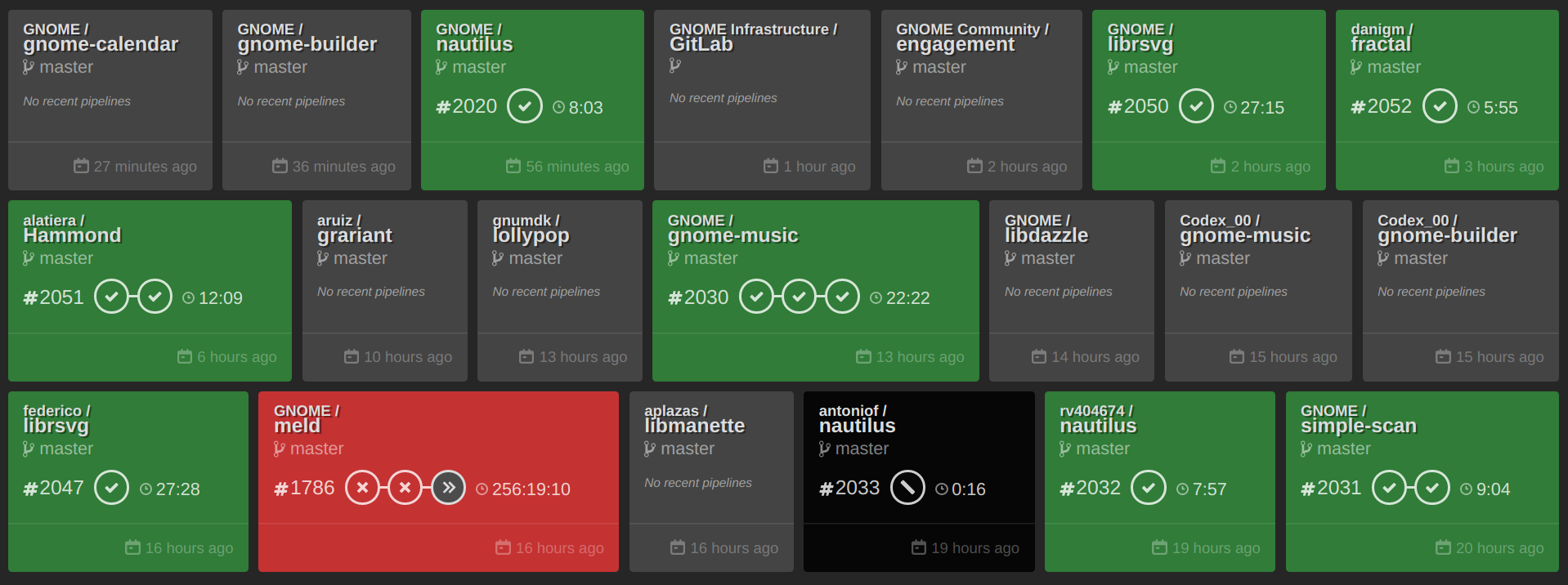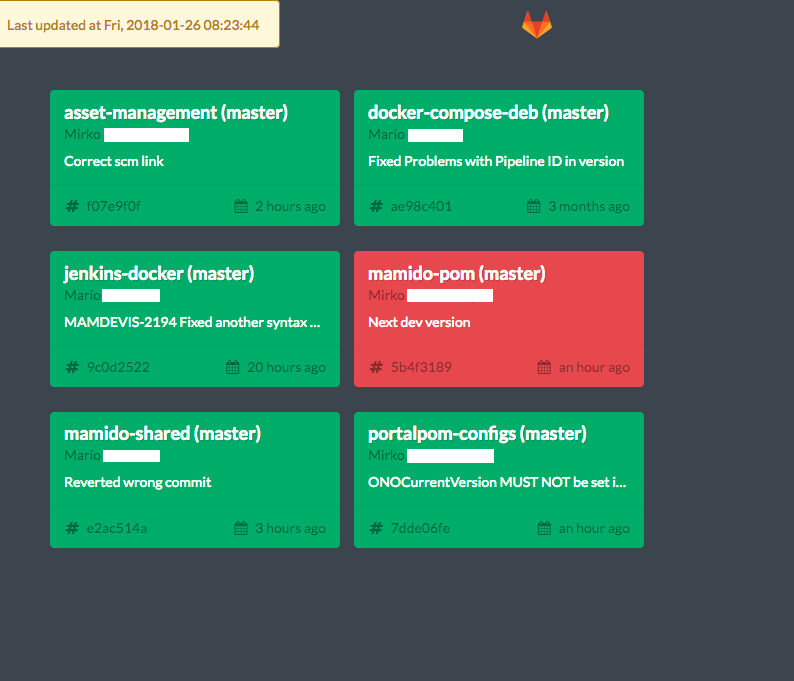🎇 Gitlab pipelines monitor – in Elm
Posted October 2020
ℹ️ This is adapted from a talk I gave last year at Elm London Finally got round to bloggifying… You can also just check out the project on Gitlab.

Background
What?
- It’s a CI visualisation for Gitlab, now hosted at https://gitlab.com/declension
- Uses Elm 0.19, ParcelJS, Gitlab v4 API
- Designed for always-on bigscreens in the office (EDIT: remember them?)
Pretty alpha right nowEDIT: seems to be stable, some missing things…
Why?
Good reasons! Elm!
- 🆙 Exciting FP use-cases
- 🤔 Also: learning experience on complex REST APIs, mutable data, and asynchronicity
- 🎨 A focus on smooth animations and dark UIs
- ⛙ Need to get default and other merge request branches, too
Existing Apps
Let’s face it – this is not new territory #### gitlab-monitor 
gitlab-ci-monitor

Issues
- Not registered as apps
- “Not made here”, let’s be honest.
- 😱 Dangerous lack of emoji on existing products
- ⛔ This has to stop!
Challenges
The Gitlab API
- REST API with oAuth2-style authentication.
/projectsand/groupsare useful root resources- So we can list project pipelines:
HTTP GET /projects/:id/pipelines - But…
Everything’s Changing
- Projects’ metadata gets updated
- Ordering is (currently) on last update, so order changes…
- New branches appear…
- New pipelines appear in various branches…
- Previously ❓ become ✔️ or ✖️…
Data fan-out
- Each group has many projects
- …each project has many pipelines
- …each pipeline can have many stages
- …each stage has many jobs…
- …each job has many steps…
- 😱
A word about GraphQL
- GraphQL is actually a great for “under-fetching”…
- …but progress was stalled indefinitely at Gitlab.
- 🆕 No, no, it isn’t any more
- But let’s stick with the REST version for now…
Back to authentication
- Aiming to avoid “paste your token here”
- Gitlab is an oAuth 2 provider
- Supports three common flows…
oAuth 2 Flows
- 🔐 Web application – server side
- 🌐 Implicit grant – SPAs etc
- 😞 Resource owner password credentials
– secured host
Getting this to work
Elm setup
Simple Elm project
- 🎁 Yarn to build, Parcel.JS to do all the magic
- 💅 SASS for styling
Current Data Model
type alias Model =
{ config : Flags
, key : Nav.Key
, token : Maybe Token
, data : GitlabData
, url : Url.Url
}Data structure itself
type alias ProjectId =
Int
type alias GitRef =
String
type alias GitlabData =
{ projects : List Project
, pipelines : Dict ProjectId (List Pipeline)
}Records
type alias Pipeline =
{ ref : String
, id : Int
, status : Status
, url : String
}
type alias Project =
{ id : Int
, namespace : String
, name : String
, description : Maybe String
, url : String
, lastActivity : Posix
}
type alias PipelineStore =
Dict ProjectId (Dict GitRef (List Pipeline))Implicit Grant Flow
- One needs to register an app first:

Implicit Grant URL
- Then redirect user to a URL like
https://gitlab.example.com/oauth/authorize ?client_id=APP_ID &redirect_uri=REDIRECT_URI &state=UNIQUE_STATE_HASH &scope=REQUESTED_SCOPES- They’ll come back at
REDIRECT_URI, with a token in the URL
HTTP with auth
getUrl : Token -> Url -> (Result Http.Error a -> Msg) -> Decoder a -> Cmd Msg
getUrl token url msg decoder =
Http.request
{ method = "GET"
, url = Url.toString url
, body = emptyBody
, expect = expectJson msg decoder
, headers = [ header "Authorization" ("Bearer " ++ token) ]
, timeout = Just (httpTimeout * 1000.0)
, tracker = Nothing
}Parse that token!
This… works…
extractToken : Url -> Maybe Token extractToken url = url.fragment |> Maybe.map (String.append "http://DUMMY?") |> Maybe.andThen Url.fromString |> Maybe.andThen (Url.Parser.parse (query toToken)) |> Maybe.withDefault Nothing
Simple Subscriptions
subscriptions : Model -> Sub Msg
subscriptions _ =
Time.every (10 * 1000) Tick- We’ll use chained messages though, so this isn’t everything…
Less Simple Messages
type Msg
= Tick Posix
| LinkClicked Browser.UrlRequest
| GotPipelinesFor ProjectId (Result Http.Error (List Pipeline))
| GotProjects (Result Http.Error (List Project))
| UrlChanged Url.UrlLessons learned
Nested mutable data is hard
- Incomplete data makes for some challenges of its own in FP
- Caching is key (arguably the whole data structure is a cache)
- This is a case study for GraphQL in many ways
Parcel.JS
- …is insanely fast 🚀
- Elm integration “just works”
- Supports
.env, SASS out of the box - I / we won’t be using Webpack much now 😁 (EDIT: I haven’t and that’s great)
Obvious notes to self
- Don’t leave slides to the day
beforeitself - Especially if you also custom-build the slide framework…
- Especially if that’s in Haskell 😆
But wait, there’s more
- Mutable nested data can be… hard
- Lenses aren’t really a thing in Elm:

- Which is probably good, I guess..
- (though
elm-monoclelooks interesting)